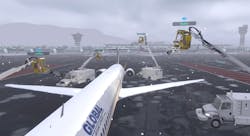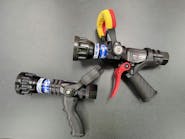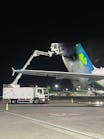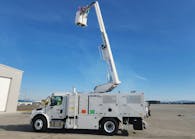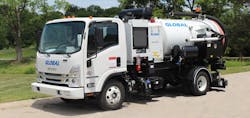Between wasted deicing fluid, fuel spent operating trucks and the risk of damage to both aircraft and GSE, the costs associated with deicing operations training can be extensive.
So in order to give ground service providers the experience required to safely deice airplanes without unneeded expenses, Global Ground Support has introduced a simulator designed specifically for use with virtual reality.
The commercial version of the Gen2 VR Deicing Simulator was released in December of 2016 – nine years after the company’s original version was released.
The Gen2 model, which offers access to 18 different aircraft and multi-user functionality, has an updated graphic engine that allows for full virtual reality.
“Up to eight users can deice the same aircraft either as the basket operator or driver,” explains Jeff Walsh, Executive Vice President for Worldwide Sales, Service and Marketing at Global. “A ninth person can supervise and evaluate everyone’s performance.”
The Gen2 simulator offers training for the Global Ultimate 2200 AirPlus with Enclosed Cab; Global Ultimate 2200 Open Basket; and Global ER2875 AirPlus with Enclosed Cab.
In order to make simulations as realistic as possible, several variables are provided, including FAA holdover times built in and changed based on precipitation and temperature; full fluid dynamics; and multiple wind scenarios that affect the fluid as it comes out of the nozzle.
The simulator then scores users based on their performance.
“It allows operators to train in simulated winter weather conditions, variable wind speeds/direction, time of day, etc.,” Walsh says. “Most vehicle training occurs at the end of summer or early fall, which does not come close to representing the actual conditions they will deice in.
“Most operators never train on actual aircraft,” he adds. “And for some, the first time they spray on an airplane, it is a live departure with passengers.”
Global’s simulator can be set up in less than an hour, and the company provides eight hours of training with each new simulator.
The simulator, which requires less than 3 sq. meters of floor space, includes the actual armrests and joysticks from the deicer, along with an Oculus Rift VR device, computer, 50” monitor, software and other required components.
According to Walsh, the Gen1 simulator is utilized by 77 customers while four customers currently operate the Gen 2. Customers include airlines, ground handlers, service providers and the United States Air Force.
While customers have not been charged for updates to the Gen 1 Simulator, the Gen2 Simulator requires different hardware and cannot be run on the older systems, the company says. However, Walsh believes current and future updates to the Gen2 will make investing in the new model worthwhile.
“Since we own the software, we will always be adding additional features, aircraft and, hopefully, other GSE equipment,” Walsh says.
